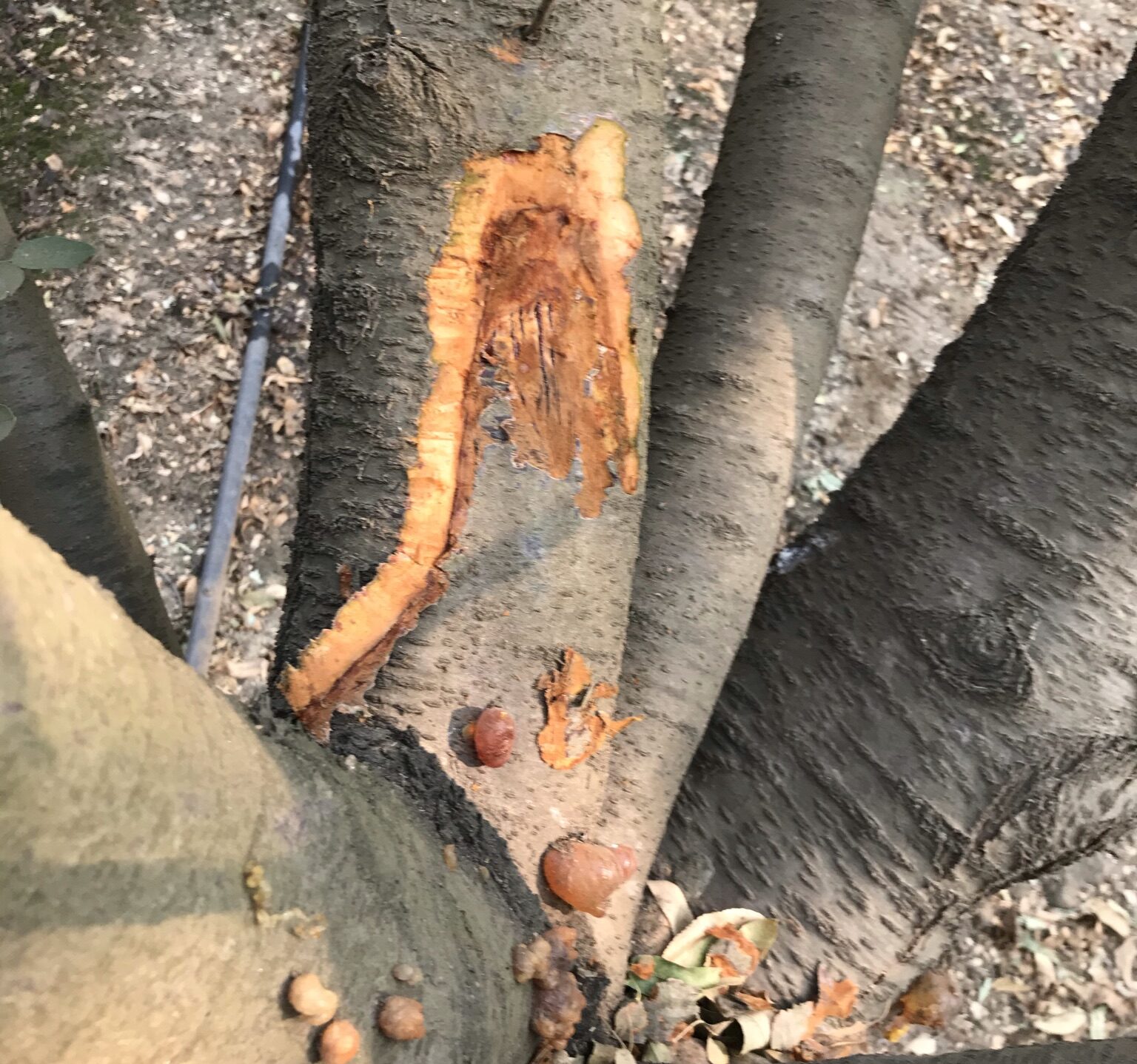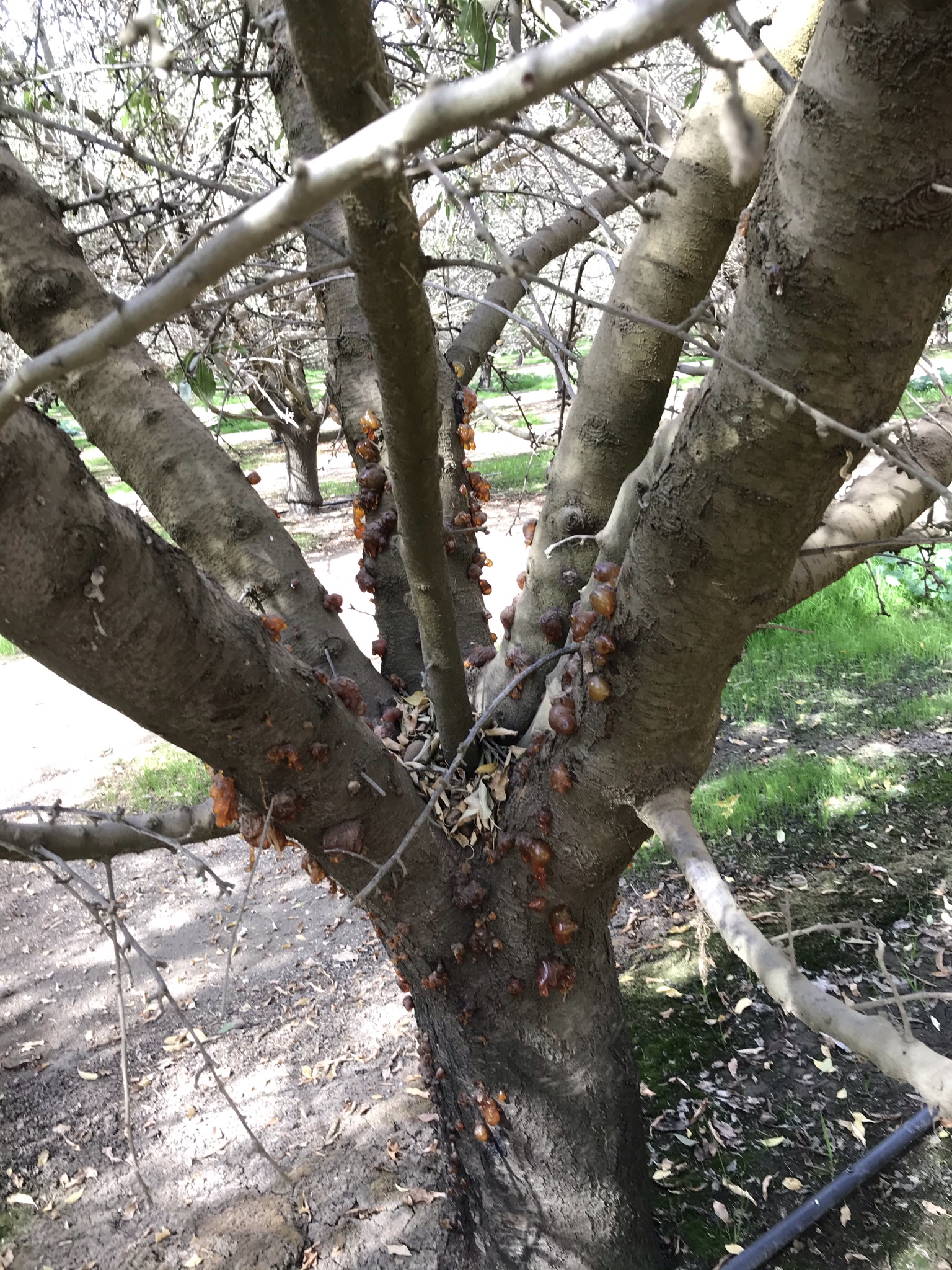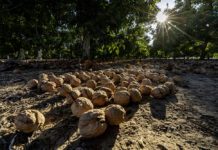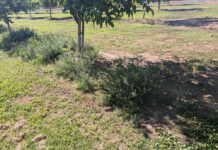
Of the many pathogens affecting California almond and walnut production, Phytophthora species rank high on any list of concerns.
Phytophthora species are widespread in orchard soils, difficult to control and can be deadly to trees. They are generally classified as soilborne, but can occur and move in surface water and can be moved up onto above ground tree surfaces as evidenced by a recent resurgence of Perennial Phytophthora Canker (PPC). Pathogenic Phytophthora can enter a tree through a wound, but wounds are not necessary for infection.
Young trees are particularly susceptible to Phytophthora diseases, and their presence can wreak havoc in establishing orchards, according to Jim Adaskaveg, UC Riverside professor and plant pathologist.
“Currently, epidemics are occurring in many newly planted almond and walnut orchards,” Adaskaveg said, “and thousands of trees are being lost.”
The most common diseases associated with Phytophthora in walnuts and almonds are crown and root rots. Crown rots advance rapidly and, according to the UC Statewide IPM Program website, infected trees can collapse and die soon after the first warm weather of spring. Trees suffering from root rots, on the other hand, may go years before succumbing to the disease, but typically will experience reduced growth, early senescence and leaf fall and yield poorly throughout their life.
While chemical control options are limited, several cultural practices can minimize an orchard’s exposure to Phytophthora diseases, the most crucial being proper water management. Keeping orchard soils well-drained and preventing water from accumulating around the crowns of trees can go a long way toward reducing incidence of Phytophthora diseases, Adaskaveg said. But doing so is easier said than done, particularly when establishing an orchard.
“Bare-root and potted trees have small root systems that need water,” Adaskaveg said. “Irrigation emitters are often placed near trunks and cardboard tree trunk-and-crown protectors seem to provide a favorable environment for Phytophthora infections.”
While none of the widely available and adapted almond rootstock is highly resistant to Phytophthora, some are more susceptible than others. In general, according to the IPM website, plum rootstocks are more resistant than peach or peach-almond hybrids, and Marianna 2624 is the most tolerant. Growers should be aware that peach-almond hybrid rootstocks, which have become popular in much of the San Joaquin Valley, are more susceptible than the old standard, Nemaguard rootstock, said USDA Agricultural Research Service Plant Pathologist Greg Browne.
In walnuts, Paradox hybrid rootstock (typically Juglans Hindsii x J. regia) is more tolerant of Phytophthora species than Northern California black walnut or English walnut rootstock. But Browne said that only RX1 rootstock, a clonal hybrid of Juglans microcarpa x J. regia, offers high resistance to P. cinnamomi and moderate to high resistance to P. citricola.
The IPM site advises walnut growers to plant on berms, avoid soil compaction, limit irrigation run times and avoid standing irrigation water.
For almonds, the website recommends growers employ similar cultural practices and provide adequate drainage to low spots in orchards as well as leaving areas without adequate drainage unplanted. Further, if planting in an area where Phytophthora is present, either plant trees on small mounds as shallowly as possible or on broad ridges with the upper roots near the soil level.
Chemical Control
None of the chemicals labeled for Phytophthora diseases provide total control of the pathogen’s diseases, according to the site, and fumigating soil pre-plant only temporarily reduces the population of Phytophthora in soil. Applications of phosphite fungicides can be quite beneficial, but, in general, fungicides don’t have much curative activity on Phytophthora diseases, according to Browne, particularly in cases where a tree has extensive cankers or gumming.
Nevertheless, Browne said, in previous almond and walnut orchard trials, phosphite treatments before infection suppressed development of Phytophthora cankers. He suggested that phosphite treatments may be beneficial in suppressing further incidence of a well-documented Phytophthora problem in almond and walnut orchards.
Ridomil also can be effective when applied in a timely fashion for controlling Phytophthora caused by root and crown rots, according to Mohammad Yaghmour, UCCE Farm Advisor for Kern County, and should be considered when planning multiple sprays. UC research has shown that over reliance on phosphite fungicides in other crops, such as citrus, can lead to resistance and poor performance, said Adaskaveg.
Alternative chemical control options could be available in the near future, given that Adaskaveg is researching fungicides with different modes of action than currently labeled products. He noted that Orondis (oxathiapiprolin), which is currently being reviewed by the state of California, was federally registered on almond in December of last year and most likely will be registered in California in late 2021. Adaskaveg is looking at pre-plant and immediate post-plant chemigation treatments to protect newly planted trees and said the new fungicides “are highly effective at extremely low rates.”
He added, however, that pre-plant and immediate post-plant applications won’t necessarily protect trees from Phytophthora introduced to an orchard from surface water irrigation, which has been shown to be a source of Phytophthora infection. “Well water is generally free of the pathogen,” Adaskaveg said. “However, surface water can carry inoculum of Phytophthora spp., resulting in re-introduction of the pathogen into an orchard even after fungicide use.”
Researchers are developing a two-application strategy with root flushes – one in the spring and another in later summer or early fall – as a strategy to contend with this re-introduction. “This is important, particularly in the first few years of establishing an orchard,” Adaskaveg said.

Phytophthora Canker
A concerning development in almonds in recent years is a resurgence of what is known as Perennial Phytophthora Canker disease (PPC). PPC, which caused high incidence of tree loss in the late 1990s and early 2000s in Southern San Joaquin County, occurred in several almond orchards in Kern County over the past three years, most notably over the past two years, according to Yaghmour.
According to Browne, who has studied PPC extensively, the disease seems to be associated with late-winter and spring rains, which create conditions ideal for infection to spread into trees from inoculum that has gathered on dust and debris in tree scaffolds.
“Those pockets where the scaffold branches join the tree trunk are really a perfect setup for infection, because you often get growth cracks where the scaffold branches push against each other and split as they grow,” Browne said. “And those scaffold pockets also tend to collect water and hold it for a while until you get infections of trees from these swimming spores (of Phytophthora) that collect there. Once infected, almond itself is a really susceptible tissue.”
Researchers have found that inoculum of Phytophthora can reach tree trunks or scaffolds in at least three ways: by moving up from roots and crowns, by flood waters along riparian ecosystems (mainly in Northern California) and through infected dust and debris that are blown from the orchard floor into trees by equipment during harvest. Almond trees infected with PPC develop cankers that can grow several feet a year and that will eventually girdle a portion or all of a tree. Several thousand trees have been lost to the disease in the past two years, according to Adaskaveg. He added that he and Browne are working to develop new management strategies for this type of Phytophthora infection.
In the meantime, phosphite fungicides can provide protection from aerial Phytophthora, according to Yaghmour.
“Phosphites will not kill the pathogen,” Yaghmour said, “but it will stop the progression of the disease.” He added that in cases where growers gain control of the disease and then stop using phosphites, there is a possibility the canker will reactivate.
Good scaffold selection also can be key to preventing problems with aerial Phytophthora, Yaghmour added. “If you have good scaffold selection, it will not only help with the prevention of Phytophthora, but it will help with the prevention of other canker diseases as well.”















